Abstract
The nicotinic acetylcholine receptor (AChR) is a large membrane protein found in muscle cells. It is involved in the transformation of acetylcholine packets into a membrane depolarization, which thereby leads to a muscle twitch. This large, complex molecule is the target of the autoimmune attack in myasthenia gravis, and much has been learned in the past decade about myasthenia by the induction of autoimmunity to AChR in experimental animals. Experimental autoimmune myasthenia gravis (EAMG) has been produced in a variety of animals by immunization with AChR or AChR-like material, or by the passive transfer of anti-AChR antibodies or lymphocytes from afflicted animals into normal animals. EAMG is a remarkably faithful model of human myasthenia and has provided much information about how the immune response to AChR progresses and how weakness and damage to the neuromuscular junction ensure. EAMG has also allowed the development of a number of revolutionary forms of treatment in which only the abnormal response to AChR is restrained, and other necessary immune functions are left intact. These advances in treatment are not far from being tested in human myasthenia gravis. The experience gained in applying these concepts in EAMG and human myasthenia will be helpful in developing similar forms of treatment for other autoimmune diseases.
Full text
PDF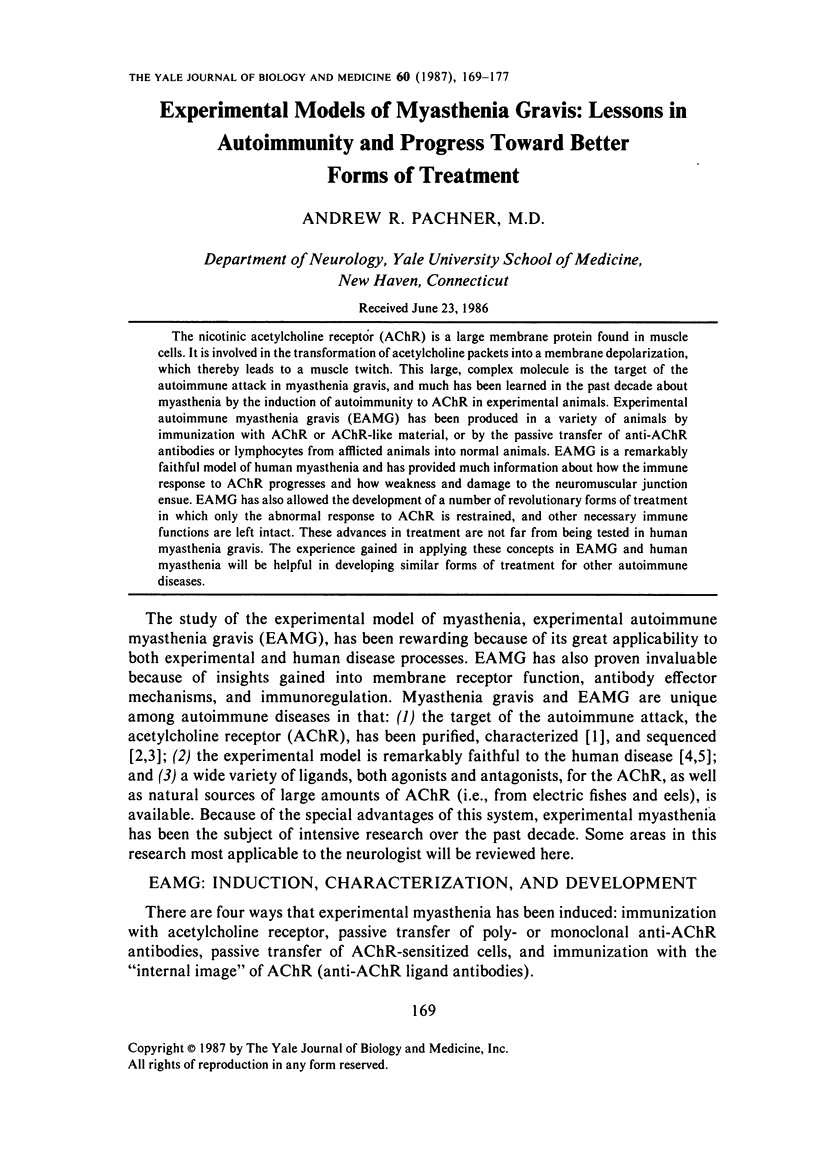
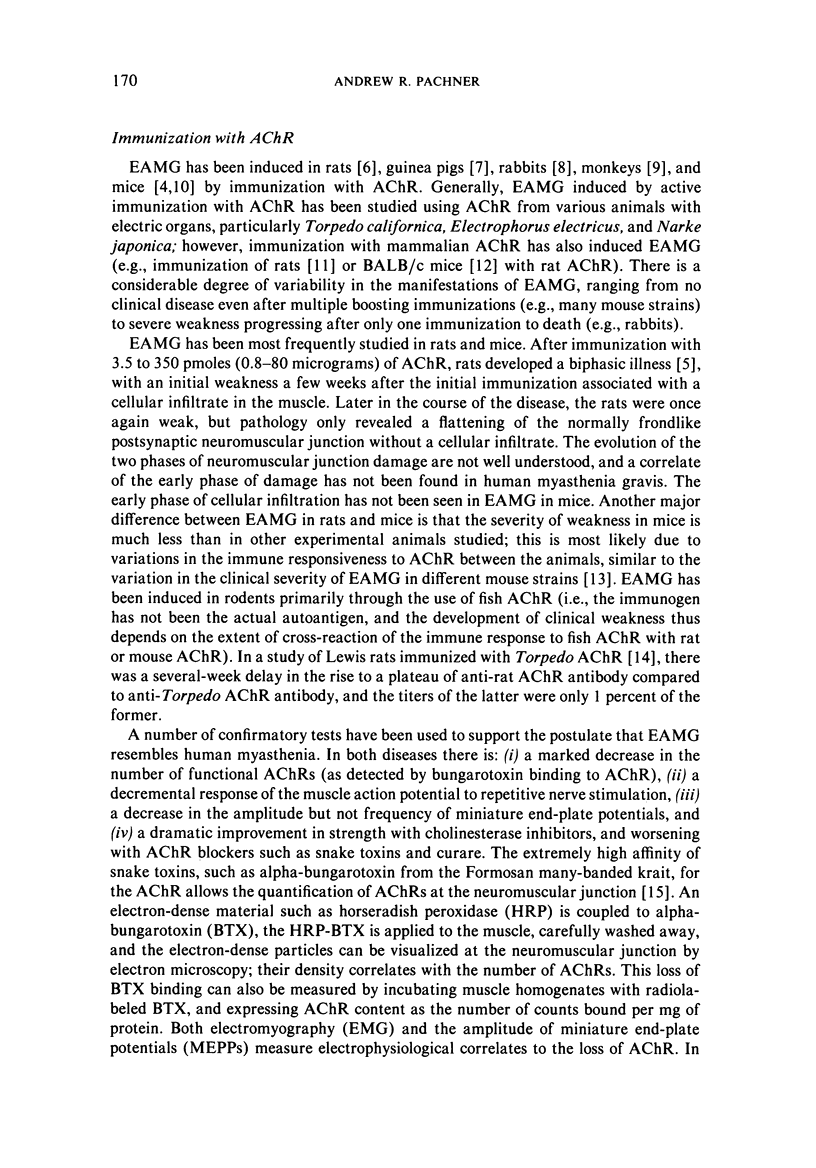
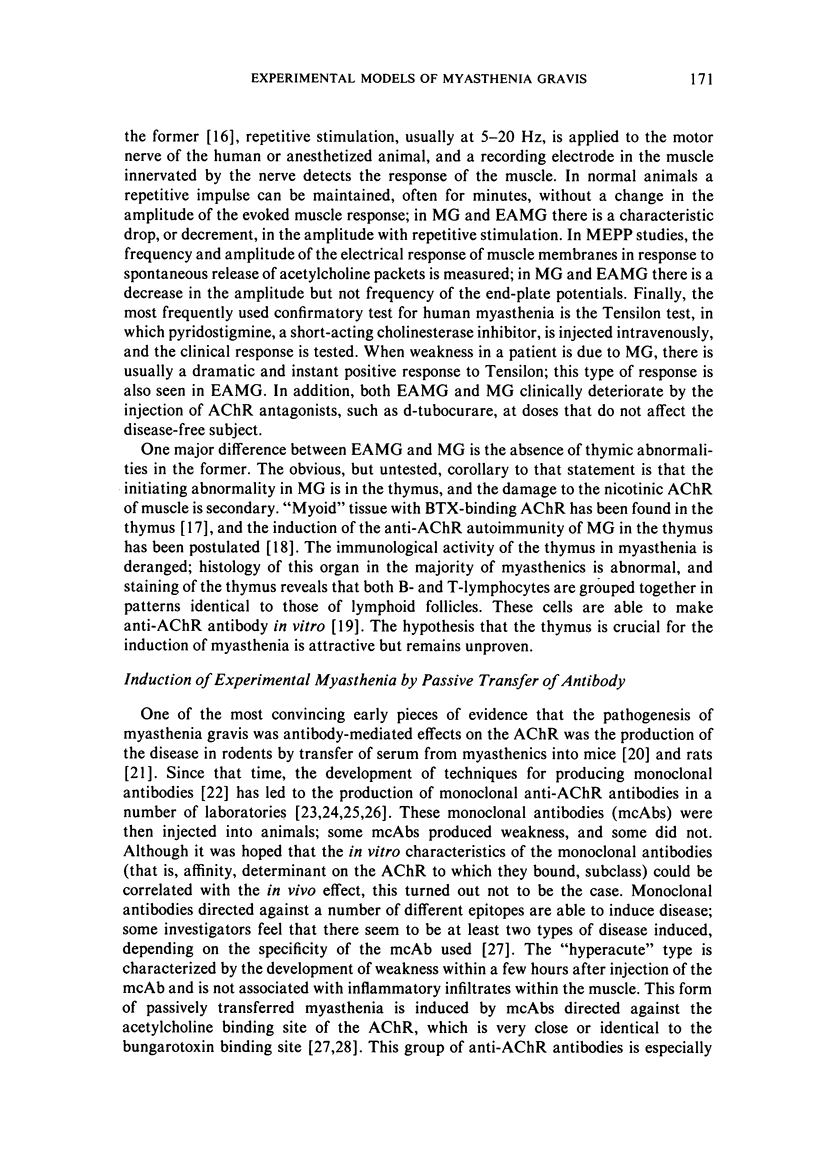
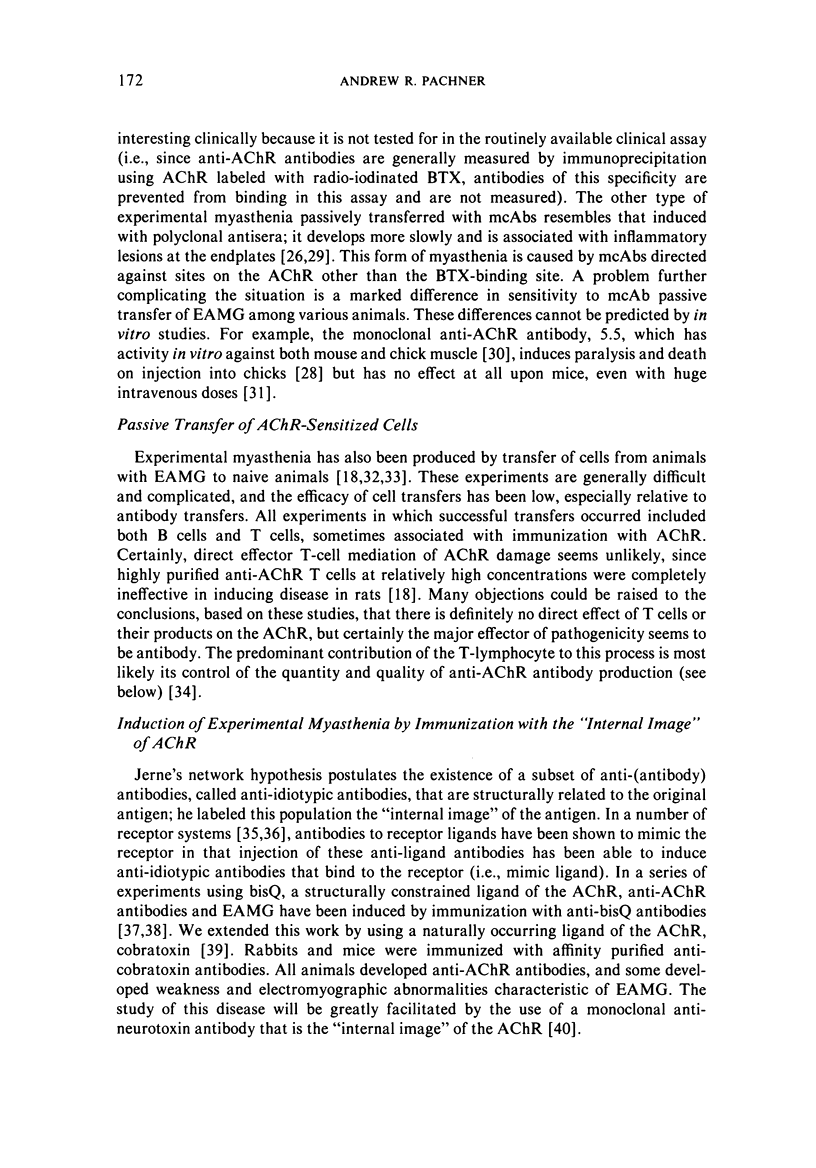
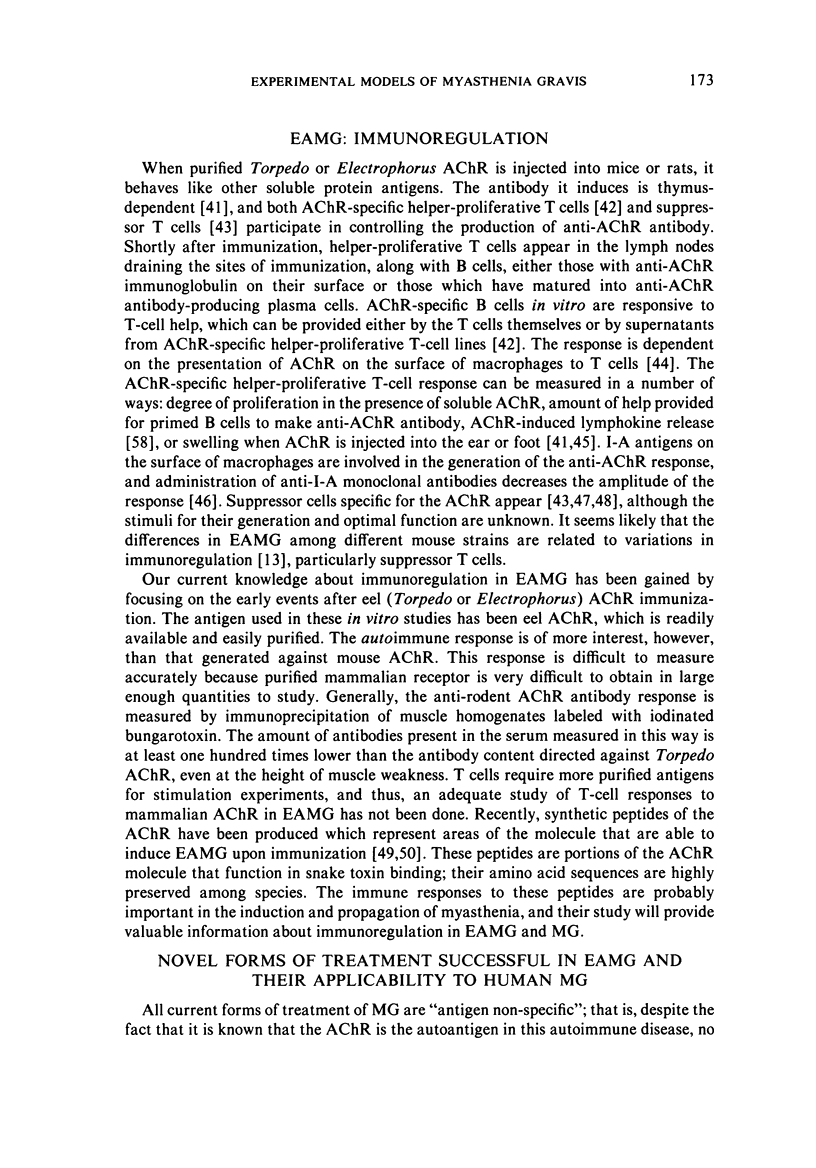
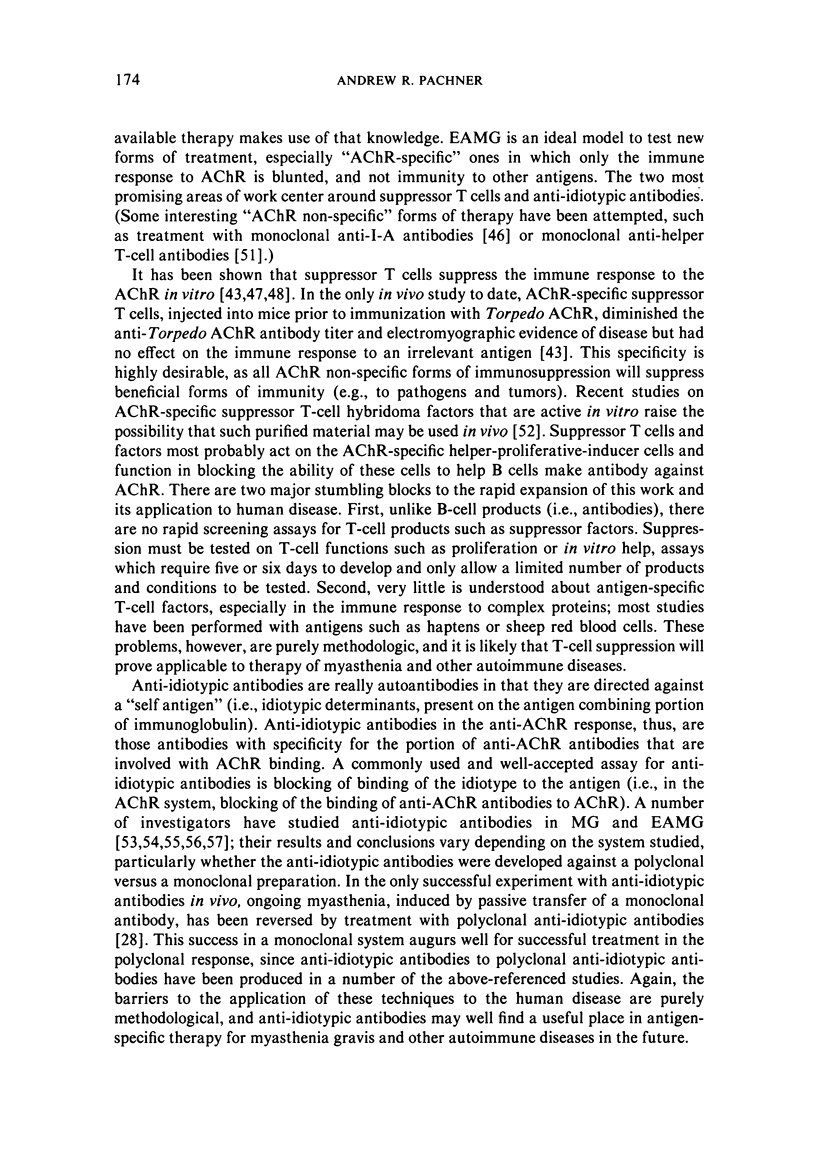
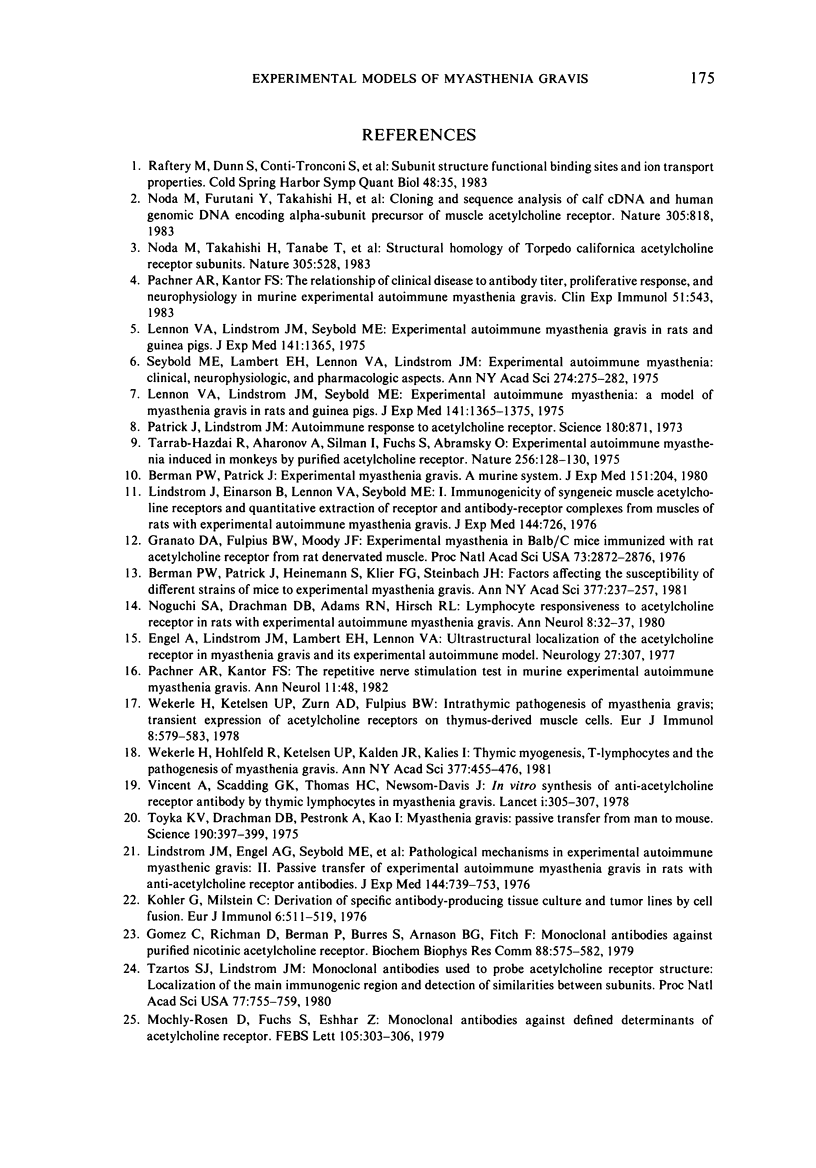
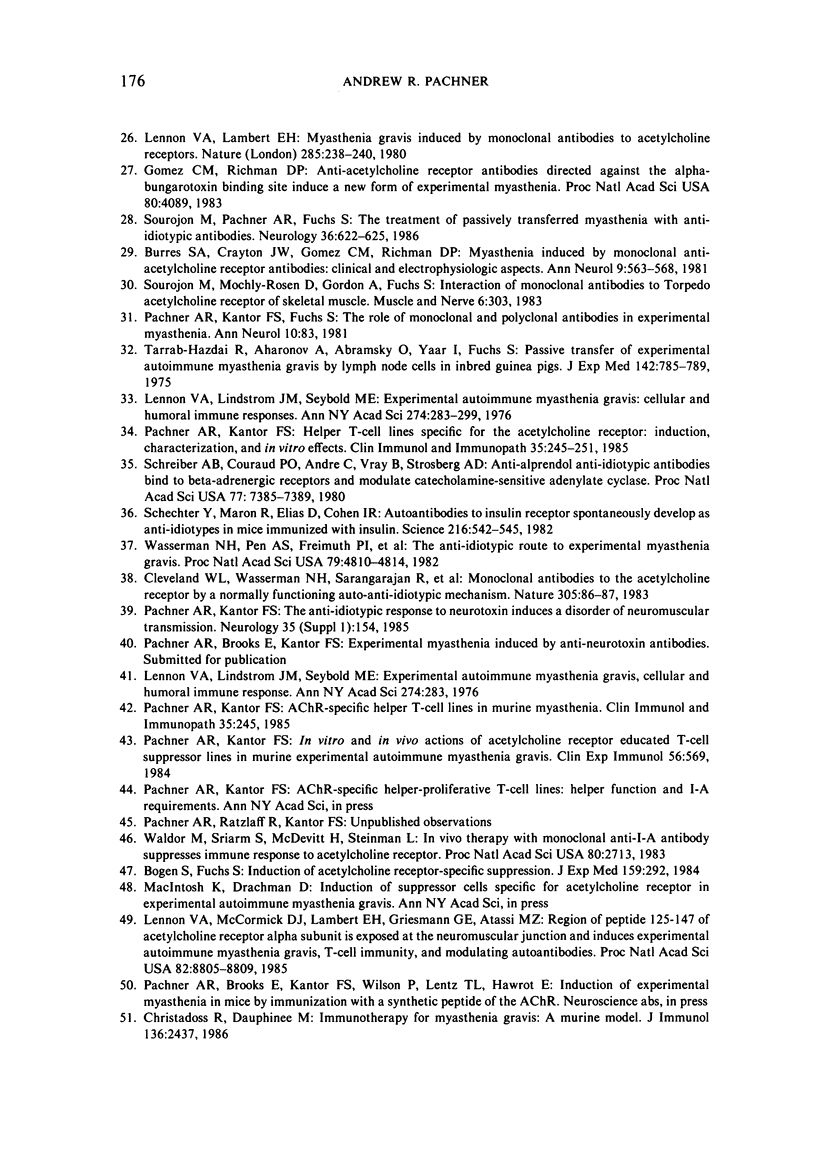
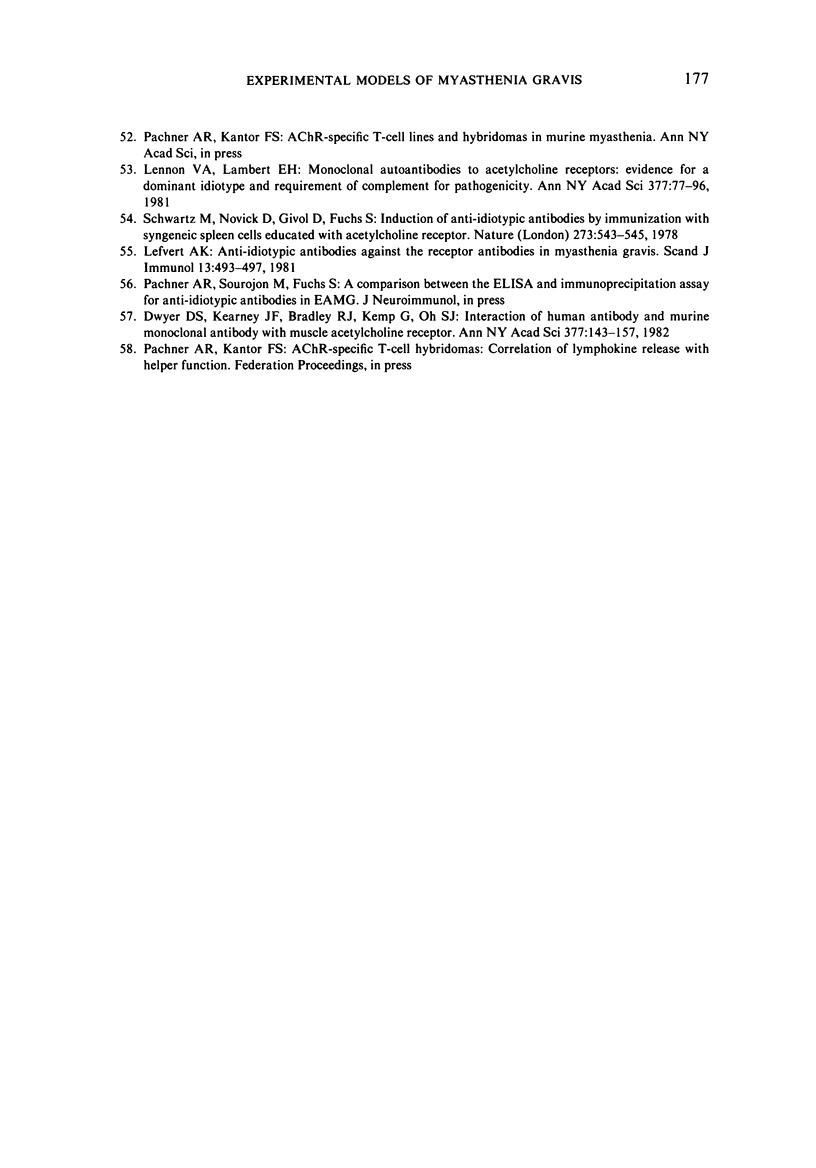
Selected References
These references are in PubMed. This may not be the complete list of references from this article.
- Bartfeld D., Fuchs S. Fractionation of antibodies to acetylcholine receptor according to antigenic specificity. FEBS Lett. 1979 Sep 15;105(2):303–306. doi: 10.1016/0014-5793(79)80635-3. [DOI] [PubMed] [Google Scholar]
- Berman P. W., Patrick J. Experimental myasthenia gravis. A murine system. J Exp Med. 1980 Jan 1;151(1):204–223. doi: 10.1084/jem.151.1.204. [DOI] [PMC free article] [PubMed] [Google Scholar]
- Berman P. W., Patrick J., Heinemann S., Klier F. G., Steinbach J. H. Factors affecting the susceptibility of different strains of mice to experimental myasthenia gravis. Ann N Y Acad Sci. 1981;377:237–257. doi: 10.1111/j.1749-6632.1981.tb33736.x. [DOI] [PubMed] [Google Scholar]
- Bogen S., Mozes E., Fuchs S. Induction of acetylcholine receptor-specific suppression. An in vitro model of antigen-specific immunosuppression in myasthenia gravis. J Exp Med. 1984 Jan 1;159(1):292–304. doi: 10.1084/jem.159.1.292. [DOI] [PMC free article] [PubMed] [Google Scholar]
- Burres S. A., Crayton J. W., Gomez C. M., Richman D. P. Myasthenia induced by monoclonal anti-acetylcholine receptor antibodies: clinical and electrophysiological aspects. Ann Neurol. 1981 Jun;9(6):563–568. doi: 10.1002/ana.410090609. [DOI] [PubMed] [Google Scholar]
- Changeux J. P., Bon F., Cartaud J., Devillers-Thiéry A., Giraudat J., Heidmann T., Holton B., Nghiêm H. O., Popot J. L., Van Rapenbusch R. Allosteric properties of the acetylcholine receptor protein from Torpedo marmorata. Cold Spring Harb Symp Quant Biol. 1983;48(Pt 1):35–52. doi: 10.1101/sqb.1983.048.01.006. [DOI] [PubMed] [Google Scholar]
- Christadoss P., Dauphinee M. J. Immunotherapy for myasthenia gravis: a murine model. J Immunol. 1986 Apr 1;136(7):2437–2440. [PubMed] [Google Scholar]
- Engel A. G., Lindstrom J. M., Lambert E. H., Lennon V. A. Ultrastructural localization of the acetylcholine receptor in myasthenia gravis and in its experimental autoimmune model. Neurology. 1977 Apr;27(4):307–315. doi: 10.1212/wnl.27.4.307. [DOI] [PubMed] [Google Scholar]
- Gomez C. M., Richman D. P. Anti-acetylcholine receptor antibodies directed against the alpha-bungarotoxin binding site induce a unique form of experimental myasthenia. Proc Natl Acad Sci U S A. 1983 Jul;80(13):4089–4093. doi: 10.1073/pnas.80.13.4089. [DOI] [PMC free article] [PubMed] [Google Scholar]
- Gomez C. M., Richman D. P., Berman P. W., Burres S. A., Arnason B. G., Fitch F. W. Monoclonal antibodies against purified nicotinic acetylcholine receptor. Biochem Biophys Res Commun. 1979 May 28;88(2):575–582. doi: 10.1016/0006-291x(79)92087-4. [DOI] [PubMed] [Google Scholar]
- Granato D. A., Fulpius B. W., Moody J. F. Experimental myasthenia in Balb/c mice immunized with rat acetylcholine receptor from rat denervated muscle. Proc Natl Acad Sci U S A. 1976 Aug;73(8):2872–2876. doi: 10.1073/pnas.73.8.2872. [DOI] [PMC free article] [PubMed] [Google Scholar]
- Köhler G., Milstein C. Derivation of specific antibody-producing tissue culture and tumor lines by cell fusion. Eur J Immunol. 1976 Jul;6(7):511–519. doi: 10.1002/eji.1830060713. [DOI] [PubMed] [Google Scholar]
- Lefvert A. K. Anti-idiotypic antibodies against the receptor antibodies in myasthenia gravis. Scand J Immunol. 1981;13(5):493–497. doi: 10.1111/j.1365-3083.1981.tb00161.x. [DOI] [PubMed] [Google Scholar]
- Lennon V. A., Lambert E. H. Monoclonal autoantibodies to acetylcholine receptors: evidence for a dominant idiotype and requirement of complement for pathogenicity. Ann N Y Acad Sci. 1981;377:77–96. doi: 10.1111/j.1749-6632.1981.tb33725.x. [DOI] [PubMed] [Google Scholar]
- Lennon V. A., Lambert E. H. Myasthenia gravis induced by monoclonal antibodies to acetylcholine receptors. Nature. 1980 May 22;285(5762):238–240. doi: 10.1038/285238a0. [DOI] [PubMed] [Google Scholar]
- Lennon V. A., Lindstrom J. M., Seybold M. E. Experimental autoimmune myasthenia gravis: cellular and humoral immune responses. Ann N Y Acad Sci. 1976;274:283–299. doi: 10.1111/j.1749-6632.1976.tb47693.x. [DOI] [PubMed] [Google Scholar]
- Lennon V. A., Lindstrom J. M., Seybold M. E. Experimental autoimmune myasthenia gravis: cellular and humoral immune responses. Ann N Y Acad Sci. 1976;274:283–299. doi: 10.1111/j.1749-6632.1976.tb47693.x. [DOI] [PubMed] [Google Scholar]
- Lennon V. A., Lindstrom J. M., Seybold M. E. Experimental autoimmune myasthenia: A model of myasthenia gravis in rats and guinea pigs. J Exp Med. 1975 Jun 1;141(6):1365–1375. doi: 10.1084/jem.141.6.1365. [DOI] [PMC free article] [PubMed] [Google Scholar]
- Lennon V. A., Lindstrom J. M., Seybold M. E. Experimental autoimmune myasthenia: A model of myasthenia gravis in rats and guinea pigs. J Exp Med. 1975 Jun 1;141(6):1365–1375. doi: 10.1084/jem.141.6.1365. [DOI] [PMC free article] [PubMed] [Google Scholar]
- Lennon V. A., McCormick D. J., Lambert E. H., Griesmann G. E., Atassi M. Z. Region of peptide 125-147 of acetylcholine receptor alpha subunit is exposed at neuromuscular junction and induces experimental autoimmune myasthenia gravis, T-cell immunity, and modulating autoantibodies. Proc Natl Acad Sci U S A. 1985 Dec;82(24):8805–8809. doi: 10.1073/pnas.82.24.8805. [DOI] [PMC free article] [PubMed] [Google Scholar]
- Lindstrom J. M., Einarson B. L., Lennon V. A., Seybold M. E. Pathological mechanisms in experimental autoimmune myasthenia gravis. I. Immunogenicity of syngeneic muscle acetylcholine receptor and quantitative extraction of receptor and antibody-receptor complexes from muscles of rats with experimental automimmune myasthenia gravis. J Exp Med. 1976 Sep 1;144(3):726–738. doi: 10.1084/jem.144.3.726. [DOI] [PMC free article] [PubMed] [Google Scholar]
- Lindstrom J. M., Engel A. G., Seybold M. E., Lennon V. A., Lambert E. H. Pathological mechanisms in experimental autoimmune myasthenia gravis. II. Passive transfer of experimental autoimmune myasthenia gravis in rats with anti-acetylcholine recepotr antibodies. J Exp Med. 1976 Sep 1;144(3):739–753. doi: 10.1084/jem.144.3.739. [DOI] [PMC free article] [PubMed] [Google Scholar]
- Noda M., Furutani Y., Takahashi H., Toyosato M., Tanabe T., Shimizu S., Kikyotani S., Kayano T., Hirose T., Inayama S. Cloning and sequence analysis of calf cDNA and human genomic DNA encoding alpha-subunit precursor of muscle acetylcholine receptor. 1983 Oct 27-Nov 2Nature. 305(5937):818–823. doi: 10.1038/305818a0. [DOI] [PubMed] [Google Scholar]
- Noda M., Takahashi H., Tanabe T., Toyosato M., Kikyotani S., Furutani Y., Hirose T., Takashima H., Inayama S., Miyata T. Structural homology of Torpedo californica acetylcholine receptor subunits. Nature. 1983 Apr 7;302(5908):528–532. doi: 10.1038/302528a0. [DOI] [PubMed] [Google Scholar]
- Noguchi S. A., Drachman D. B., Adams R. N., Hirsch R. L. Lymphocyte responsiveness to acetylcholine receptor in rats with experimental autoimmune myasthenia gravis. Ann Neurol. 1980 Jul;8(1):32–37. doi: 10.1002/ana.410080105. [DOI] [PubMed] [Google Scholar]
- Pachner A. R., Kantor F. S. Helper T-cell lines specific for the acetylcholine receptor: induction, characterization, and in vitro effects. Clin Immunol Immunopathol. 1985 May;35(2):245–251. doi: 10.1016/0090-1229(85)90070-4. [DOI] [PubMed] [Google Scholar]
- Pachner A. R., Kantor F. S. Helper T-cell lines specific for the acetylcholine receptor: induction, characterization, and in vitro effects. Clin Immunol Immunopathol. 1985 May;35(2):245–251. doi: 10.1016/0090-1229(85)90070-4. [DOI] [PubMed] [Google Scholar]
- Pachner A. R., Kantor F. S. Nerve stimulation test in murine experimental autoimmune myasthenia gravis. Ann Neurol. 1982 Jan;11(1):48–52. doi: 10.1002/ana.410110109. [DOI] [PubMed] [Google Scholar]
- Pachner A. R., Kantor F. S. The relation of clinical disease to antibody titre, proliferative response and neurophysiology in murine experimental autoimmune myasthenia gravis. Clin Exp Immunol. 1983 Mar;51(3):543–550. [PMC free article] [PubMed] [Google Scholar]
- Patrick J., Lindstrom J. Autoimmune response to acetylcholine receptor. Science. 1973 May 25;180(4088):871–872. doi: 10.1126/science.180.4088.871. [DOI] [PubMed] [Google Scholar]
- Schreiber A. B., Couraud P. O., Andre C., Vray B., Strosberg A. D. Anti-alprenolol anti-idiotypic antibodies bind to beta-adrenergic receptors and modulate catecholamine-sensitive adenylate cyclase. Proc Natl Acad Sci U S A. 1980 Dec;77(12):7385–7389. doi: 10.1073/pnas.77.12.7385. [DOI] [PMC free article] [PubMed] [Google Scholar]
- Schwartz M., Novick D., Givol D., Fuchs S. Induction of anti-idiotypic antibodies by immunisation with syngeneic spleen cells educated with acetylcholine receptor. Nature. 1978 Jun 15;273(5663):543–545. doi: 10.1038/273543a0. [DOI] [PubMed] [Google Scholar]
- Seybold M. E., Lambert E. H., Lennon V. A., Lindstrom J. M. Experimental autoimmune myasthenia: clinical, neurophysiologic, and pharmacologic aspects. Ann N Y Acad Sci. 1976;274:275–282. doi: 10.1111/j.1749-6632.1976.tb47692.x. [DOI] [PubMed] [Google Scholar]
- Shechter Y., Maron R., Elias D., Cohen I. R. Autoantibodies to insulin receptor spontaneously develop as anti-idiotypes in mice immunized with insulin. Science. 1982 Apr 30;216(4545):542–545. doi: 10.1126/science.7041258. [DOI] [PubMed] [Google Scholar]
- Souroujon M. C., Mochly-Rosen D., Gordon A. S., Fuchs S. Interaction of monoclonal antibodies to Torpedo acetylcholine receptor with the receptor of skeletal muscle. Muscle Nerve. 1983 May;6(4):303–311. doi: 10.1002/mus.880060410. [DOI] [PubMed] [Google Scholar]
- Souroujon M. C., Pachner A. R., Fuchs S. The treatment of passively transferred experimental myasthenia with anti-idiotypic antibodies. Neurology. 1986 May;36(5):622–625. doi: 10.1212/wnl.36.5.622. [DOI] [PubMed] [Google Scholar]
- Tarrab-Hazdai R., Aharonov A., Silman I., Fuchs S., Abramsky O. Experimental autoimmune myasthenia induced in monkeys by purified acetylcholine receptor. Nature. 1975 Jul 10;256(5513):128–130. doi: 10.1038/256128a0. [DOI] [PubMed] [Google Scholar]
- Tarrab-Hazdi R., Aharonov A., Abramsky O., Yaar I., Fuchs S. Passive transfer of experimental autoimmune myasthenia by lymph node cells in inbred guinea pigs. J Exp Med. 1975 Sep 1;142(3):785–789. doi: 10.1084/jem.142.3.785. [DOI] [PMC free article] [PubMed] [Google Scholar]
- Toyka K. V., Brachman D. B., Pestronk A., Kao I. Myasthenia gravis: passive transfer from man to mouse. Science. 1975 Oct 24;190(4212):397–399. doi: 10.1126/science.1179220. [DOI] [PubMed] [Google Scholar]
- Tzartos S. J., Lindstrom J. M. Monoclonal antibodies used to probe acetylcholine receptor structure: localization of the main immunogenic region and detection of similarities between subunits. Proc Natl Acad Sci U S A. 1980 Feb;77(2):755–759. doi: 10.1073/pnas.77.2.755. [DOI] [PMC free article] [PubMed] [Google Scholar]
- Vincent A., Scadding G. K., Thomas H. C., Newsom-Davis J. In-vitro synthesis of anti-acetylcholine-receptor antibody by thymic lymphocytes in myasthenia gravis. Lancet. 1978 Feb 11;1(8059):305–307. doi: 10.1016/s0140-6736(78)90073-9. [DOI] [PubMed] [Google Scholar]
- Waldor M. K., Sriram S., McDevitt H. O., Steinman L. In vivo therapy with monoclonal anti-I-A antibody suppresses immune responses to acetylcholine receptor. Proc Natl Acad Sci U S A. 1983 May;80(9):2713–2717. doi: 10.1073/pnas.80.9.2713. [DOI] [PMC free article] [PubMed] [Google Scholar]
- Wassermann N. H., Penn A. S., Freimuth P. I., Treptow N., Wentzel S., Cleveland W. L., Erlanger B. F. Anti-idiotypic route to anti-acetylcholine receptor antibodies and experimental myasthenia gravis. Proc Natl Acad Sci U S A. 1982 Aug;79(15):4810–4814. doi: 10.1073/pnas.79.15.4810. [DOI] [PMC free article] [PubMed] [Google Scholar]
- Wekerle H., Hohlfeld R., Ketelsen U. P., Kalden J. R., Kalies I. Thymic myogenesis, T-lymphocytes and the pathogenesis of myasthenia gravis. Ann N Y Acad Sci. 1981;377:455–476. doi: 10.1111/j.1749-6632.1981.tb33753.x. [DOI] [PubMed] [Google Scholar]
- Wekerle H., Ketelsen U. P., Zurn A. D., Fulpius B. W. Intrathymic pathogenesis of myasthenia gravis: transient expression of acetylcholine receptors on thymus-derived myogenic cells. Eur J Immunol. 1978 Aug;8(8):579–582. doi: 10.1002/eji.1830080808. [DOI] [PubMed] [Google Scholar]


